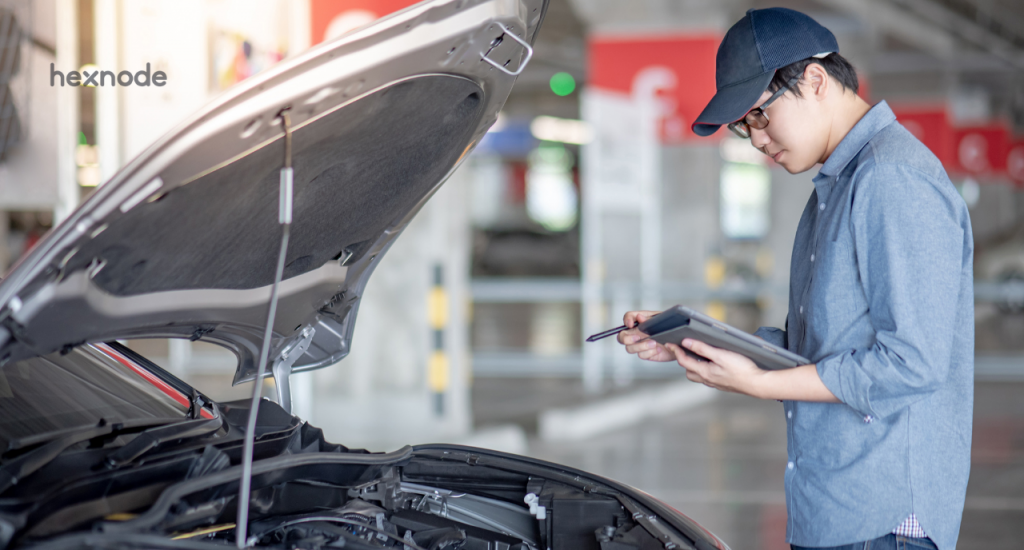Businesses are constantly evolving. New product ideas are appearing every now and then. Every product we see in the market is the outcome of years of thought and an even greater period of experimentation. Have you ever tried imagining the chain of events that results in the final product? It is no easy feat! I must warn you! What underlies it is even more complicated than the chain of events that resulted in the implementation of rugged devices in the supply chain!
- Decoding the supply chain
- Digitization and the supply chain
- Rugged devices for supply chain digitization
- A closer look at the supply chain industries and their processes
- Manufacturing sector
- Logistics and warehousing
- Retail
- Some well-known rugged device vendors for supply chain activities
- Conclusion
Decoding the supply chain
Supply chains are everywhere. We often see the term popping up when we talk about manufacturing or the transportation sector or even about the storage of goods. It seems like a term that easily fits into a lot of contexts. But what really is a supply chain?
The supply chain involves all the processes that control the flow of goods and services, from their raw form all the way to the final finished form reaching the customers.
Supply chains involve a lot of industries, from producers, vendors, warehouses, transportation, distribution centers and even the ones like retail. The raw materials are processed, and they often become the raw materials of yet another chain. Knowingly or unknowingly, this interconnected nature is pointing fingers towards the obvious factor in the supply chain process- speed. Can you even imagine an efficient supply chain without proper mechanisms to keep track of each process? Well, that can be a bit hard to imagine!
Digitization and the supply chain
We are all part of a constantly changing tech world. Digitization has conquered most industries around us. Now we are in a state where digitization has become more of a necessity than an option. To ensure digitization, companies have also begun deploying new advanced technologies like the internet of things (IoT), robotics, artificial intelligence, machine learning, etc.
The supply chain is also undergoing significant changes. Rugged devices have replaced the once prominent paper-based modes of record keeping. It has made the supply chain more efficient and has also played its part in reducing the critical factor in the supply chain -speed.
Rugged devices for supply chain digitization
There is no suspicion regarding the complexity of the supply chain process. Being a part of a larger inter-dependent chain, keeping track of each process makes it easier to focus on the time-consuming ones and adopt appropriate measures to address them. Making this vision, a reality would be impossible without the implementation of rugged devices. Rugged devices have become the new normal in the industrial sector. According to the recent report by Markets and Markets,
“The rugged device market, valued at USD 7.03 billion in 2016, is expected to reach USD 10.29billion by 2023, growing at a CAGR of 5.92% between 2017 and 2023.”
Rugged devices are effective tools that aid in the digitization process. Apart from being a vital factor in data management, its benefits are not just restricted to those.
A closer look at the supply chain industries and their processes
Supply chains are everywhere; all the finished products we see around us have a supply chain story to talk about. But, of course, it’s that same old story of raw materials and their complicated journey molding it into the form we are interested in! But there is indeed a slight difference; we now have mechanisms to keep track of everything. From the quantity of raw materials left in our Godowns to the location our trucks reached to the quantity of finished products left in that new shop, we have every information at our disposal, well, thanks to rugged devices!
Supply chain processes, though complicated, can be made faster by adopting smart implementations. From the progress in the manufacturing processes to keeping track of your shipment’s location, all these baby steps are more than enough to create a profound impact.
Manufacturing sector

Manufacturing processes often involve a lot of intermediate stages. Each process produces the raw material for the next, making each step even more critical. However, the manufacturing sector has always been reluctant to embrace digitization. While the working conditions contributed significantly towards this, other factors like mobility and device management challenges also distanced them from this implementation.
Benefits of rugged devices in the manufacturing sector
Rugged devices play a significant role in simplifying the whole process. With these devices involved in processes like inspection, quality and inventory control, machinery maintenance and order tracking, you have a clear picture of the entire process. In turn, it helps make the whole process run a lot smoother. Some of the ways in which rugged devices contribute to this include:
- Managing assets in the field with rugged devices capable of providing real-time access, even in harsh environments, making production and operations efficient and cost-effective. Industries like oil & gas, mining and the broader energy industry are examples.
- With around-the-clock information access, you can easily keep track of the whole process, making the whole process a lot smoother, even in the harshest physical conditions.
- Easier to manage each operation in a manufacturing plant with rugged devices being easily compatible with multiple industrial automation infrastructure programs and applications, improving the visibility of the entire process.
- Rugged devices let you access the Internet of things (IoT), the cloud gateways and a host of technologies that reduce cost, boost productivity and performance.
- Speeding up the fleet management process by coordinating the shipping, receiving, fleet communication, route optimization, field monitoring etc., with others like billing and system uptime/safety.
- Digital technologies and advanced analytics giving field crew to executives unprecedented granular views and control over the constantly changing physical environment, thus enhancing its efficiency.
- Rugged tablets on the shop floor provide access to engineering schematics and work-in-progress tracking to keep management, suppliers and customers informed.
Some areas that need to be addressed
Manufacturing processes themselves are complicated. With rugged device implementation, our main goal is to make the whole process easier, but what if it goes against the intended purpose? Well, that can be disastrous! When you are in a situation where you need to manage the entire fleet of organizational devices, deploying the essential software manually, solving device issues as and when they appear, and a lot more, you can’t totally rule out the possibility of things getting more complicated.
Logistics and warehousing

Supply chain processes involve a lot of industries. It involves everything from procuring raw materials to the final finished product reaching our customers. In this process, we often encounter intermediate stages, where the raw materials are either in transit or are stored in warehouses until a need for these materials arises again. So, without these industries in place, it would be impossible to keep track of the goods stored and transport them to the required places as and when required.
Benefits of rugged devices in the logistics and warehousing sector
Logistics and warehousing often need to handle a lot of commodities. With such a large amount of goods to handle and keep track of, managing the whole system without a digitization mechanism can be a near-impossible task. With digitization and rugged device implementation keeping track of the goods being stored and those which are being transported is no more tedious. Some of the ways in which rugged devices contribute to this include:
- Effectively managing inventory, allowing employees to handle these devices throughout their shift without worrying about accidental falls.
- Easily keep track of items stored in extreme hot or cold conditions with rugged devices as they can withstand these conditions.
- Easy to alert the warehouse of shipment damage, making it easier to get the rest of the shipment in case of an emergency.
- Tablets makes it easier to automate Department of Transportation hours of service (HOS) tracking, driver logs, and pre-trip inspections, along with access to onboard GPS and turn-by-turn directions, dispatch and scheduling information, and inventory and invoicing capabilities – all on one device.
- Real-time tracking of trucks and their shipments with built-in GPS on the tablets to provide updates to customers about when trucks are arriving or departing the facilities making it easier to track goods from production to loading.
- Volume dimensioning of commodities to ensure accurate billing of commodities saving much of the productive time.
- Sensors and smart software make it easier to monitor fleet vehicles, including temperature for vehicles transporting food or precious cargo, real-time repair alerts etc.
Some areas that need to be addressed
Supply chains hit the headlines recently. But, unfortunately, for all the wrong reasons. Currently, supply chains are widely targeted by hackers. According to a study by cybersecurity company BlueVoyant,
“97% of firms have been impacted by a cybersecurity breach in their supply chain”
To be more precise, the logistics and the transportation sector are increasingly becoming targets of such attacks. The main reason for this is their high sensitivity to disruption. As these businesses can’t afford to lose time or systems, they often end up giving ransoms to get their systems operational as soon as possible.
“A report published on April 22 by security services provider BlueVoyant finds that last year saw three times as many ransomware attacks on shipping and logistics firms as in 2019.”
Retail

Retail is the industry that comes at the end of the supply chain process. It’s the customer-facing industry dealing with all aspects, from keeping track of the inventory in stores to receiving payments from the customers. It’s demanding to be a customer-facing sector as we often need to consider customer satisfaction or in other terms the convenience factor. Implementing devices that are convenient, and at the same time, offering secure payment modes can be quite a challenge.
Benefits of rugged devices in the retail processes
The retail sector is often considered the last step in the supply chain process. Being the sector that comes in direct contact with the customers, it deals with everything from store inventory management to customer management and receiving payments. Some of the ways in which rugged devices contribute to this include:
- Selling tools enable associates to check inventory levels and product customization options alongside customer management.
- Handheld mobile devices make it easier to locate items in inventory, make purchases and schedule delivery, preventing chances of stockouts and customers leaving empty-handed.
- Bar code and RFID scanners letting sales associates quickly check stock and perform price lookups.
- Rugged devices with software applications that facilitate data entry and transfer, store operations, line bursting, promotion tracking etc.
- Credit card readers, signature capture, MSR, Chip or Pin reader integration enabling transactions from anywhere in the store.
- Instant information and transaction completion, eliminating the need for customers going to counter or register.
- Single platform for shipping and receiving, unifying inventory management.
- Managers are no more stuck in the back of a PC, instead, they can spend more time on the floor with guests.
- Special screens allowing easy viewing for associates even in direct sunlight during outdoor operations
Some areas that need to be addressed
The retail sector is the ‘money sector’ that deals with customers and the payments that they need to make. Being such a critical industry, it’s no wonder how data security comes first on the list. In the present scenario of social engineering and hackers switching to a variety of hacking methods, we can’t afford to have any loopholes in our rugged device framework.
Some well-known rugged device vendors for supply chain activities
There are a lot of rugged device vendors serving a variety of industries. Hexnode offers OEM support for vendors whereby OEM and UEM work together to provide the best management capabilities. Some of the supported vendors are listed below:

Featured resource
Rugged devices in the Enterprise
Rugged devices are being adopted in a wide range of industries due to their ability to withstand a range of outdoor conditions. But being equipped with OS like any other endpoint, their challenges are no different from the others. Get to know about the benefits of rugged devices and learn how to secure them with Hexnode.
Download pdfConclusion
Rugged devices have changed the face of the supply chain industry. It has undergone a significant shift from an industry that was difficult to keep track of to a fully managed one with information on every process available to us. It’s now possible to get information on a wide range of aspects, from the location of the goods in transit to the quantity of the stock left in the warehouse., a situation that could only be imagined before the advent of rugged devices! However, rugged devices also come with their set of weak points or, in other terms, challenges that can be categorized as device management challenges. With Hexnode’s device management capabilities, supply chain management became less complicated and rugged devices, even more secure.






